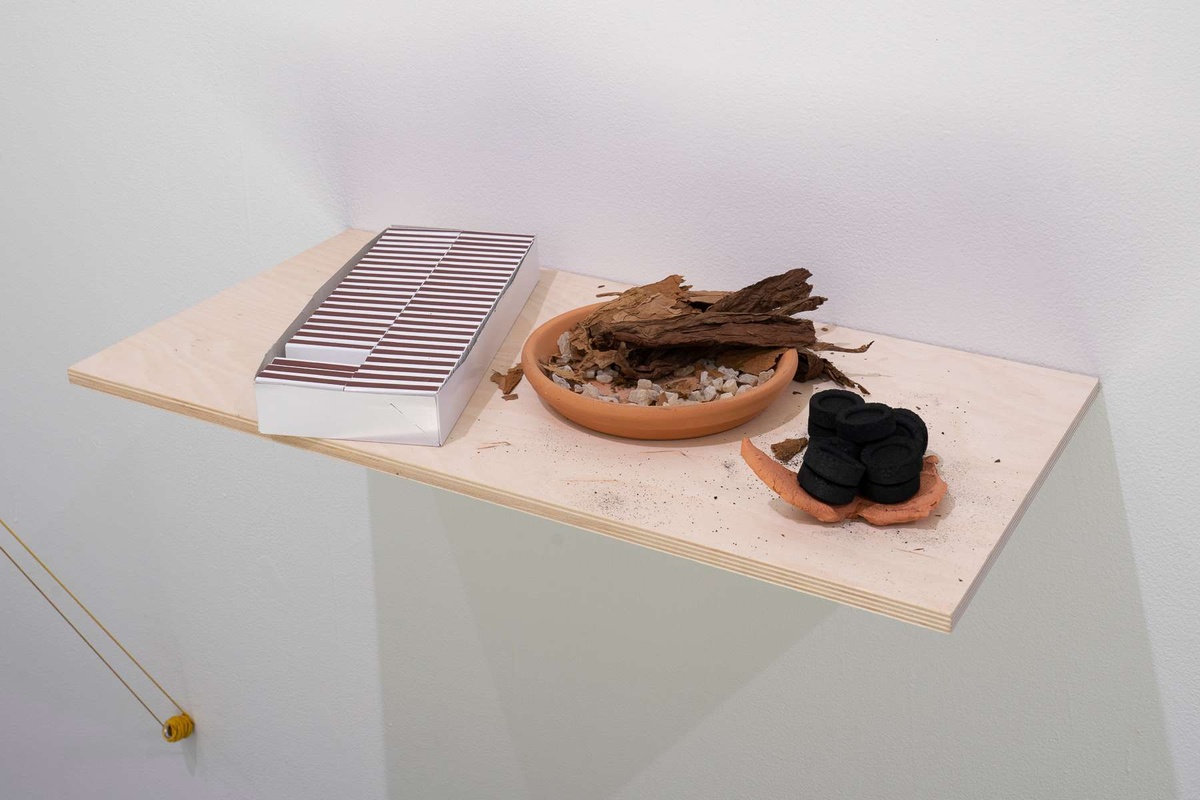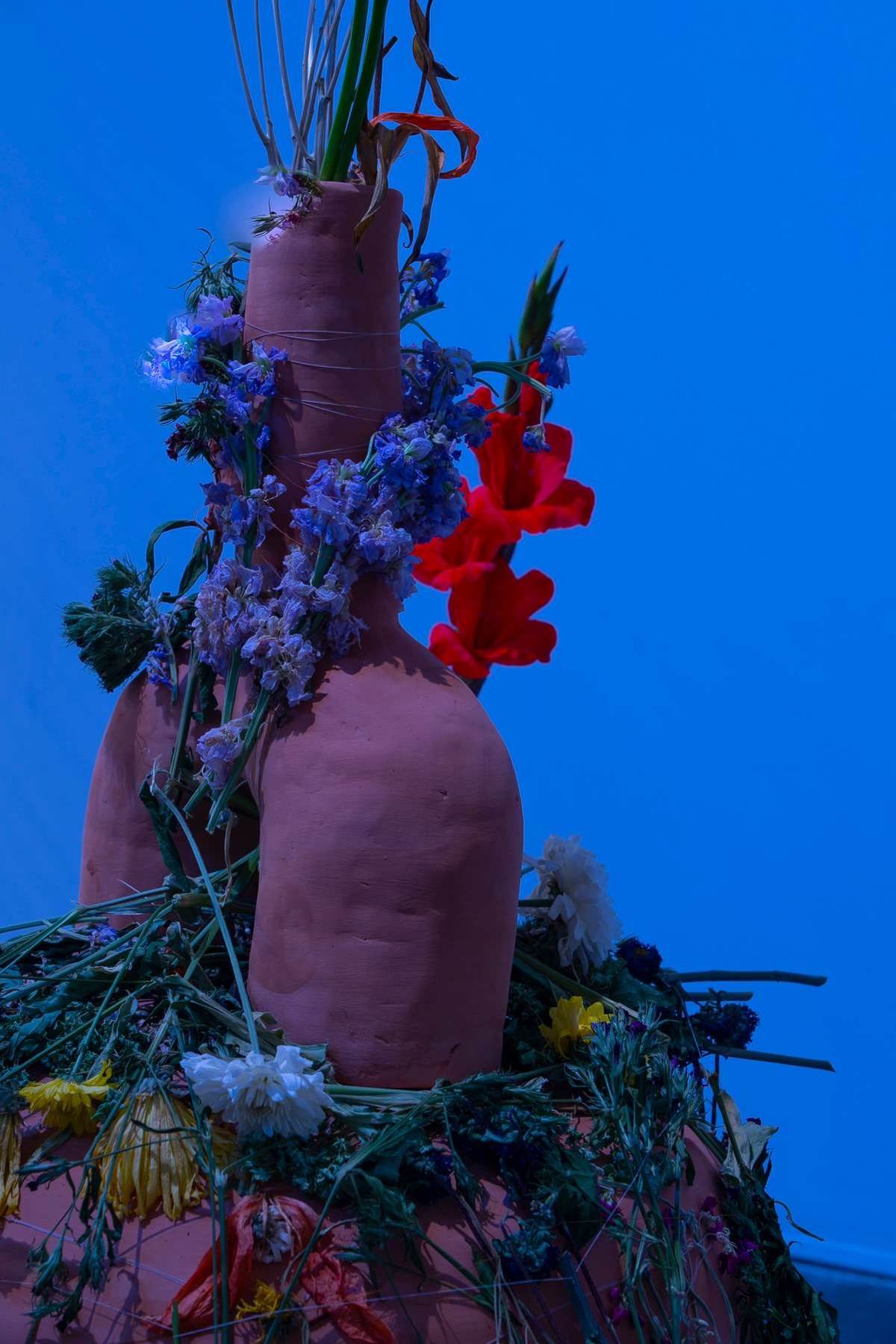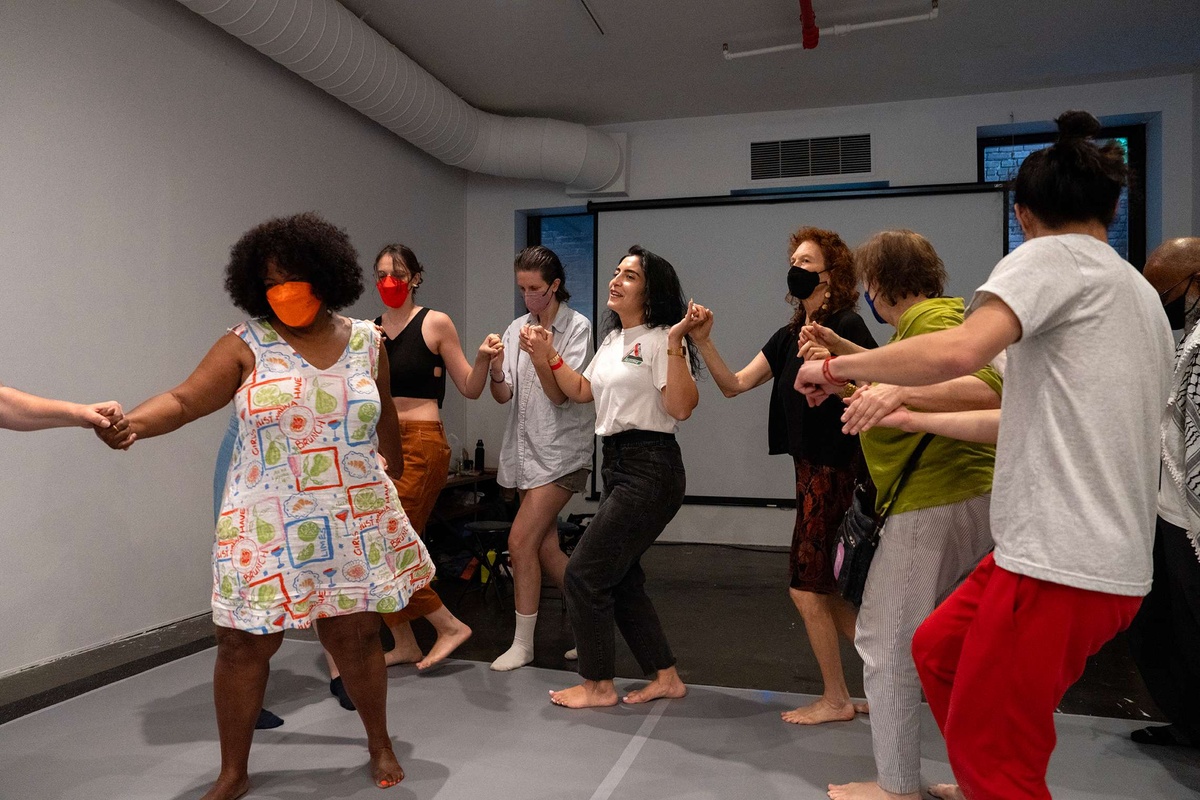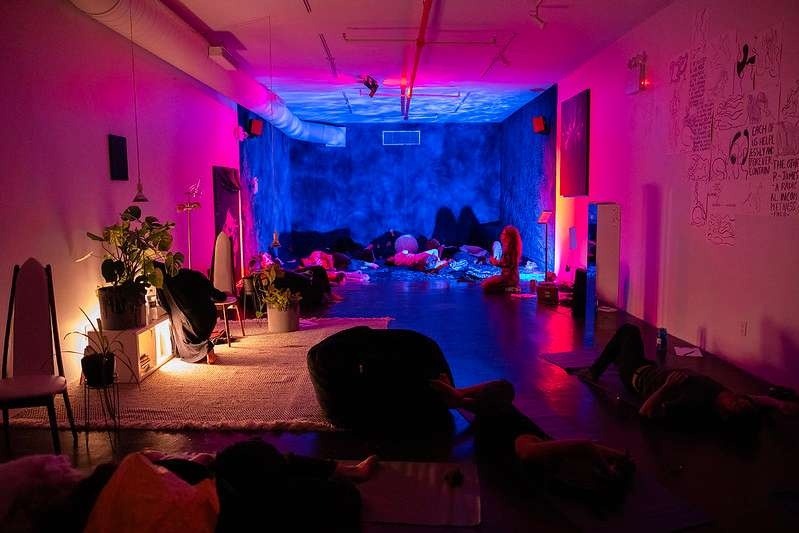Transitory States, Intimate Matter: Smoke and Scent in Petición; for Exorcism
Alexis Wilkinson
These days, it feels appropriate to have smoke on the mind.
Over the course of a few surreal months, as we watched the death toll soar and the streets swell with bodies in protest, I tracked the skies on the West Coast as they filled with ash, its deadly emissions spreading like a toxic fog. Speaking via Zoom in September 2020, Marcela and I discuss the state of things, confiding in one another a shared uncertainty about what’s next. Squinting through the haze, we can’t see clearly what is ahead.
On one of these calls, we talk about the anxiety of this not-knowing and our clouded state of mind. The connection glitches out as Marcela holds up a page with flower iconography from the The Codex Borgia, a pre-conquest Aztec illustrated manuscript, for me to see. They describe the ceramic vessels that they are beginning to produce, meant to hold flower bundles and aromatic herbs, as well as letters people have sent them memorializing deceased loved ones. These collected materials will be burned, and as they transition to ash, they’ll permeate the installation space of Petición; for Exorcism with smoke and its attendant aromas. Marcela reminds me that Mesoamerican smoke rituals are meant to service portals to dream states, ancestral spaces, and other liminal zones. Their desire is to facilitate a transition from this present fog of stress to the fog of a dream-state or an alternate plane.


Smoke box. Built by artist Marcela Torres.
In the center of the gallery space, burning incense sit on the various crevices and surfaces of a hand-sculpted clay figure. The figure rests atop a lit white platform and is enclosed by floor to ceiling vinyl curtains.
Marcela is looking to Mesoamerican curanderismo smoke rituals to do so, paying close attention to their use of tobacco and flowers. They are also drawing from the concept of Flower Mountain, a liminal realm found in the belief systems of certain North American indgenous populations that connects earth to a paradisal afterlife in the sky, and its associated floral iconography. Marcela is interested in how indigenous practices and cosmologies can be a guide to harnessing power, perseverance, and catharsis amidst the social upheaval, climate collapse, and collective grief that is coming to a head this year. Their research has brought them to consider “how indigeneity can help us to understand the cyclical nature of life and death.” From this position, rigid binaries and boundaries loosen and the liminal and the transitory emerge as the norm.
Alongside Marcela, I have been thinking about smoke and scent, related emissions that coalesce in the installation of Petición; for Exorcism. I’m taking note of how these different kinds of particle matter help elucidate notions of change, liminality, intimacy, and the unknown. Materially, smoke is the visible result of something passing from one state to another. A particulate transition-state. An excess. You could say that this condition of transition is a constant for most anything at any given moment in time; things are always (on a molecular, often imperceptible level) in some state of growth, decay, or change. Smoke also has the capacity to at once visualise and obscure, making its own presence known even as it clouds its surroundings. A scent, on the other hand, can be a powerful molecular presence, invisible to the naked eye yet perceived by entering into the body, changing form and intensity as it responds to airflow. What might we learn from transition-states like smoke and invisible matter like scent on both individual and collective registers? How might attending to smoke and scent help us understand the intimacy of the relations we have with one another and our environment? By extension, how might these traits help us to understand our porousness, our permeability?
Smoke enters the body through inhalation, making the lungs a site of vulnerability and potential irritation, easily damaged by pathogen or by force. We breathe our atmosphere in and part of us comes back out when we exhale. Smoke, therefore, can help visualize the symbiotic relationship with our environment: how we are simultaneously shaped and shaping. As I think alongside Marcela, I keep returning to this passage:
“Emanuele Coccia, in The Life of Plants: A Metaphysics of Mixture, argues that plants are the lungs through which an atmosphere in flux emerges, what he calls ‘the essence of cosmic fluidity, the deepest face of our world, the one that reveals it as the infinite mixture of all things, present, past, and future.’ … In other words, our bodies are porous sponges; we are breathing each other; we are entangled with each other; and in the face of this viral pandemic, we are vulnerable to each other.”[2] They say that we are what we eat; is it also true that we are what we breathe?


Part of the instillation, Marcela Torres: Petición; for Exorcism
Incense, matches, tobacco, and copal rest atop a wooden floating shelf
Marcela tells me that they have a cigar-smoking practice and that this has led to an interest in the use of tobacco in curanderismo rituals. They send me a text about the use of tobacco for healing and medicinal purposes, long before it was exploited by industry and turned into a harmful substance. I read that for indigenous populations in lowland South America, tobacco is understood as “a shaper and transformer of persons.”[3] It is often used in rituals or activities to facilitate in-between or liminal states that reflect a broader understanding of the body as “determined largely by external influence.”[4] I learn that while tobacco can be ingested in many different forms, the practice of smoking is predominant because of its ability to make breath visible to the naked eye.[5] In the mythologies of some indigenous populations in the American Southwest and Mesoamerica, Flower Mountain is one such liminal realm that smoke is used to access, a transitory place where celestial gods and ancestors reside and that serves as the path toward ascension to the Flower-World afterlife filled with fragrant flowers, fruits, and birds in the sky.[6] While ritual use of smoke might help one access this realm, its aroma is the sensory tether between Flower Mountain, the afterlife, and those still on earth.[7] Scent is spatial, a powerful force for place-making that doesn’t rely on visual markers; it operates on an intimate, internal, proprioceptive register. Thinking about smoke alongside scent, the porosity and permeability of self comes into relief. But a permeable self is also a vulnerable one—capable of absorbing both emotional and physical harm.


Part of the instillation, Marcela Torres: Petición; for Exorcism
Flowers in varying stages of life rest atop a hand-made clay sculpture
For Petición; for Exorcism, Marcela is creating an interactive space where ritual, exchange, catharsis, and processing can take place in an atmosphere of crisis and grief on both individual and collective levels. At first, this endeavor seems like a deviation from a previous work, Agentic Mode (2019), a performance in which Marcela embodies the position of a fighter using Muay Thai movement vocabulary, sonically-resonant self-defense training instruments, and overwhelming crests of sound and light to investigate the ways in which violence seeps from the social to the bodily register. For Petición; for Exorcism, their role has shifted from fighter-performer to a facilitator of hybrid smoke-based rituals, building a space intended for the ongoing work of processing grief. While fighting and tending appear to be in opposition, the underlying strategy of integrating a public and eliciting catharsis course through both projects. Using different strategies, Petición; for Exorcism and Agentic Mode aim to integrate or implicate their audience.
After my initial conversation with Marcela, I return to a text titled “Reading and Smoking” by artists Candice Lin and Patrick Staff, where they write: “The engineer may seek to harness the many emanations of smoke for fumigation, communication, or cooking; for its offensive and defensive capabilities. In these instances, it may become a usable toxin, a directed load, and thrust, or a series of readable signs. It is mostly disembodied from its source and its own ecosystem and significance.” [10] Marcela, then, might be positioned as the artist-engineer; through their use of material and movement vocabularies, they activate the defensive capacities of matter and movements typically understood to be offensive. In Agentic Mode, fighting techniques become choreographies of care meant to expel trauma from the body. In Petición, Marcela salvages tobacco’s healing, spiritual, and cathartic uses, reclaiming the plant from its harmful and toxic abuse by industry, in order to harness power in grief.
For those who visit, Petición; for Exorcism might be a fragrant respite at a time of toxic skies and sirens, a brief transit to something like the fog of a dream-state. Inside the installation, smoke permeates the air, emitting sweet, woody aromas and casting a mesmerizing fog into the space. Over time, the smoke builds and blurs nearby objects, softening their edges. On the walls and windowsills, flowers like lilies, marigolds, and bromeliad gather. As their petals wilt with the passing weeks, new flowers are brought in: the cycle of living and dying is on display. Here, as elsewhere, smoke and scent mingle amorphously in the air, become absorbed by our pores, and inhaled into our interior cavities, evidence of just how porous and permeable we are, breaking down a static and singular notion of self, and highlighting the intimate nature of our relationships to one another and our environment.
References
[1] Conversation with artist October 5, 2020.
[2] Beatriz Cortez, “Viral Rhizomes,” in The Word for World is Forest, ed Fiona Ball, Naz Cuguoğlu, Chloe Kwiatkowski, and Orly Vermes (San Francisco, California College of the Arts), 55.
[3] Andrew Russell and Elizabeth Rahman, “Introduction: The Changing Landscape of Tobacco Use in Lowland South America,” in The Master Plant: Tobacco in Lowland South America, ed. Andrew Russell and Elizabeth Rahman (New York: Routledge), 8.
[4] Russell and Rahman, “Introduction: The Changing Landscape of Tobacco Use in Lowland South America,” 8 – 10.
[5] Russell and Rahman, “Introduction: The Changing Landscape of Tobacco Use in Lowland South America,” 13.
[6] Karl A Taube, “Flower Mountain: Concepts of life, beauty, and paradise among the Classic Maya” RES: Anthropology and Aesthetics, no. 45 (Spring 2004): 69.
[7] Taube, “Flower Mountain: Concepts of life, beauty, and paradise among the Classic Maya,” 88. “the sacred place of contact with the supernatural realm is delineated by aroma, such as from a flower or incense.”
[8] Taube, “Flower Mountain: Concepts of life, beauty, and paradise among the Classic Maya,” 93.
[9] Marcela Torres, Artist Statement, accessed October 20, 2020, http://marcelaetorres.com/about-us
[10] Candice Lin and Patrick Staff “Reading and Smoking: Candice Lin and Patrick Staff on the Malleable Body” accessed October 20, 2020 https://walkerart.org/magazine/candice-lin-patrick-staff-hormonal-fog
About the artist
Alexis Wilkinson
Alexis Wilkinson is a curator working across dance, performance, and visual art. Recent curatorial projects include Xandra Ibarra: Forever Sidepiece at Knockdown Center, NY (2019), Extremely absorbent and increasingly hollow at Cuchifritos Gallery, NY (2018), Chloë Bass: The Book of Everyday Instruction at Knockdown Center, NY (2018), A Collection of Slow Events at The Luminary, MO (2017), In Practice: Material Deviance at SculptureCenter, NY (2017), and Matter to Whom? at the Judd Foundation, NY (2015). She has also organized exhibitions and performances for Abrons Art Center, A.I.R. Gallery, and NADA NY.
Wilkinson is the Director of Exhibitions and Live Art at Knockdown Center in Queens, NY, where she organizes interdisciplinary exhibitions, performances, and events. She was a 2017 – 2018 AIRspace curator-in-residence at Abrons Art Center, New York and the 2017 Curatorial Fellow at SculptureCenter, New York. Wilkinson has held research, administrative, and curatorial support roles at the New Museum, New York and the Hammer Museum, Los Angeles. Wilkinson holds an MA from the Center for Curatorial Studies, Bard College and a BA in Cultural Studies, Dance, and Art History from the University of California, Los Angeles.
Explore/Archive
See allJanuary 2026
Freedom Time Meditation: Cartographies of Release
Neta Bomani
Artist and educator Neta Bomani offers a guided meditation on FREEDOM TIME: Undanced Dances Through Prison Walls
December 2025
The INSTITUTE FOR TRANSHUMANIST CEPHALOPOD EVOLUTION and Learning from Octopuses
Barbara London
Barbara London reflect's of Miriam SImun's INSTITUTE FOR TRANSHUMANIST CEPHALOPOD EVOLUTION
October 2025
streamlined reflections, courtesy of noise canceling headphones
Gabrielle Rucker
Gabrielle Rucker reflects on the radical intimacy and auditory life at the heart of Deli Radio





